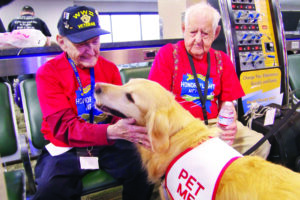By Dr. Beth Leermakers
Does your dog love meeting new people? Do you want to put a smile on people’s faces? If so, you and your dog may want to become a therapy dog team. Last month, I wrote about the stress relief benefits of interacting with therapy dogs. Studies have shown that petting a dog (or cat) reduces blood pressure and cortisol (a stress hormone) in students, healthcare workers and other stressed individuals. While working at a boarding school for overweight teens with emotional issues, I often conducted counseling sessions with my dog in the room. Snowie provided more comfort to distressed kids by his mere presence than I could with my years of clinical psychology training.

Photo courtesy of Foders.com
What is a Therapy Dog’s Job?
Therapy dogs provide physiological or psychological therapy (or just emotional comfort) to individuals other than their handlers. These dogs have calm, stable temperaments and friendly, laid-back personalities.
Therapy dogs and their handlers visit hospitals, nursing homes, rehabilitation centers, hospice patients’ homes, schools, libraries, airports and more.
Therapy dogs may visit patients, give children the confidence to read out loud, or actively participate in physical rehabilitation therapy.
Unlike service dogs, who are not supposed to interact with anyone other than their “person,” therapy dogs are encouraged to interact with — and be petted by — a variety of people while they are working. Therapy dogs may be trained by anyone, but they must meet certain standards to be certified as a therapy dog.
Does Your Dog Have What it Takes?
Therapy dog requirements vary by organization but typically include a few common criteria: age (> 1 year old), basic obedience skills and friendliness with new people. To be certified by Pet Partners, therapy dogs must be: at least one year old at the time of evaluation, have lived in the owner’s home for at least six months, be reliably house trained, be currently vaccinated against rabies, not be fed a raw meat diet, have no history of aggression or seriously injuring either people or other animals, demonstrate good basic obedience skills. Dogs should walk on a loose leash and respond reliably to common commands such as “sit,” “down,” “stay,” “come” and “leave it” and welcome, not merely tolerate, interactions with strangers.
Take the Pet Partners quiz to see if you and your pooch are ready to become a therapy team at action.petpartners.org.
Therapy Dog Volunteer Opportunities in DFW
Heart of Texas Therapy Dogs. Heart of Texas therapy dog volunteers visit more than 70 facilities in the DFW area: senior facilities, hospitals and other healthcare facilities, schools and libraries (reading programs). To volunteer with Heart of Texas, your dog must be registered with the Alliance of Therapy Dogs (ATD), a large national organization. heartoftexastd.org/volunteer
Baylor, Scott & White’s Animal Assisted Therapy program. Volunteer opportunities are available at facilities in the DFW Metroplex. Dogs must be 1-9 years old, have completed a formal obedience course and be tested in the hospital. For more information, contact program coordinator Linda Marler at 214-536-3151, [email protected] or visit bswhealth.com/about/become-a-volunteer
Children’s Hospital. Their founding pet therapy group, Paws Across Texas, has been visiting patients in playrooms, the inpatient units and inpatient psychiatry every week since 1999. To volunteer, therapy dogs and their handlers must complete the evaluation process with Paws Across Texas or Pet Partners. childrens.com/get-involved/volunteer/volunteer-dogs
Hospice programs. Several local hospice programs are looking for therapy dog teams to visit patients:
Hope Health Care. Visit hospice patients in their homes throughout the greater Dallas area. Call 972-366-5030 for more information.
Envoy Hospice (Carrollton area). Envoy Hospice is seeking certified dogs (with their owners) to provide friendly visits to hospice patients and their families. Visit envoyhospice.com.
Heart to Heart Hospice of Texas. Heart to Heart is looking for pets and owners to visit with hospice patients. Visit hearttohearthospice.com.
If you don’t have time to complete the evaluation process or volunteer, you and your pup can still brighten people’s day. While you’re out walking, let a child (supervised by his/her parent) pet your dog. Or take your dog to visit a neighbor who doesn’t get many visitors. There are many ways to provide furry warm fuzzies.
